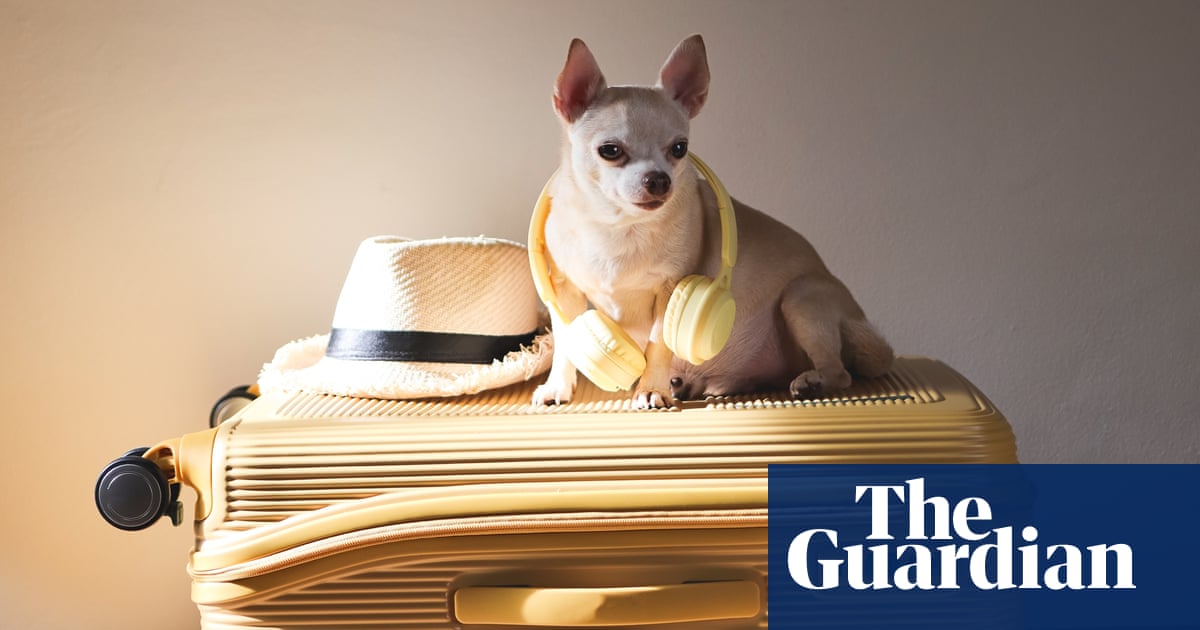“Do you have drugs?” the air steward asked us as we sat down. “Yes,” I assured him and he looked relieved. They weren’t for us but for our chihuahua, who was about to join us on a 14-hour flight from Melbourne to Abu Dhabi.
When my husband and I decided to relocate from Australia to his home country, Spain, last year, we couldn’t bear the thought of leaving our chihuahua, Achilles, behind.
We looked into pet transport companies then learned that, since 2021, some international airlines have allowed small pets to travel out of Australia in cabins rather than as cargo. The costs looked comparable so we decided to take the leap and remove the anxiety of leaving our “fur baby” in the hands of strangers. Etihad was the only airline we could find that allowed small breeds to travel with their owners onboard outbound flights – for a fee – though we’ve since discovered Korean Air provides cheaper pet tickets.
With Etihad, a pet-only ticket costs US$1,500 (A$2,360): which allows a small dog to travel in under-seat storage. This didn’t seem practical for such a long flight so we opted to pay for an additional economy seat instead.
Once we factored in the extra seat as well as the paperwork (A$543) and vet costs (A$500), in total we forked out about A$6,000 to move our dog, separate to our own travel costs. We joked that while we were in economy, Achilles flew business class.
If you don’t go through a pet transport company, pet owners have to do all the paperwork themselves. Everyone knows that bringing animals into Australia is difficult (just ask Johnny Depp) – taking them out is surprisingly bureaucratic, too. It involves health checks, permits and stamped forms, with every letter and number picked over by government vets and airline officials. The stress was considerable and we were not certain our pet would get on the plane with us until the day of travel.
You have to register your intent to “export an animal” with the Department of Agriculture well in advance (you need to plan based on factors including destination, vaccination requirements and flights). All documents have to be approved in person by the department. Etihad had to approve the documents as well. Then final health checks and paperwork have to be completed no more than three days before the flight, while the forms must be submitted to the airline at least 24 hours beforehand. There’s a narrow window to run around doing paperwork and final vet checks.
The airline staff were expecting us when we arrived at Tullamarine airport. They helped shepherd us past startled security staff, who had to call their managers because they had never dealt with pets before. While the carrier went through the X-ray machine, a member of security took our dog.
While I had been occupied with the paperwork, my husband had been making equally important preparations – training Achilles for the experience.
Airline regulations state that pets have to be kept inside an approved travel carrier at all times, so the most vital component was “crate training” him to sleep and be at ease inside a travel crate. Achilles slept in the crate every night and we took him on train trips, and walked him on a lead through Melbourne Central shopping centre, since it is similar to an airport terminal.
after newsletter promotion
When it came to the flight, we didn’t need the calming drugs provided by our vet. To our astonishment, even while human babies were screaming mid-flight, our dog stayed quiet in his crate beside us and slept most of the way. We made sure to take him for a long walk the morning before the flight, and again in the terminal. We covered his crate to minimise disturbance, had a few small treats to give him when we ate and a little water to prevent dehydration. We put a piece of antler and a chew toy in his crate for “in-flight entertainment”.
In Abu Dhabi there is no pet rest station, so we took him to a baby change room where he happily toileted on the disposable mats we trained him to use. The look on the face of the woman waiting outside with her children when two men and a chihuahua emerged was priceless. On his walkthrough the terminal, he was treated like a celebrity. At one point we were chased by a group of small kids.
On arrival in Madrid after seven more hours in the air, the woman at customs scanned Achilles’ microchip to make sure it matched the EU importation form and had a quick look at the stamps beforeadding her own. The EU’s main requirement is that dogs should be vaccinated for rabies and microchipped. “Welcome to Spain!” she said, smiling and waving us through the arrival gates with our dog trotting alongside. It seemed anticlimactic after all that stress.
We can attest that dogs, like people, suffer jet lag. At 2am that night, Achilles was awake in the hotel room and needed to be taken for a walk through the rowdy streets. Perhaps he was just acclimatising to the rhythm of Spanish nightlife.
If we eventually return to Australia, the only option we have is to put Achilles in cargo, so we would probably use a pet transport company. The alternative is forking out for a private jet. Either way, a period of quarantine in a facility remains mandatory, unless you want to face the ire from the likes of Barnaby Joyce.









